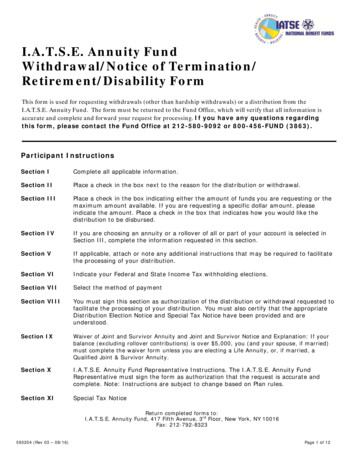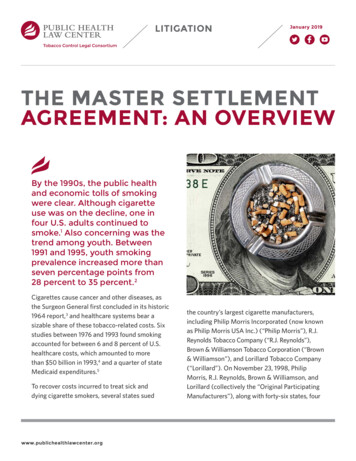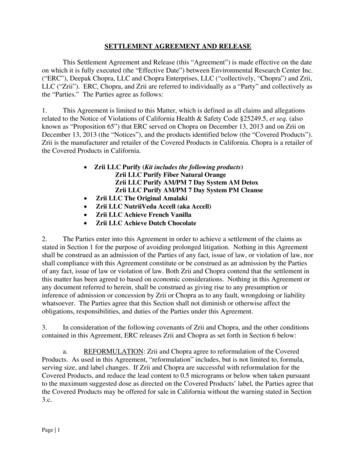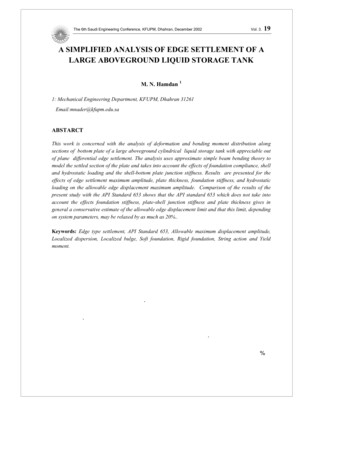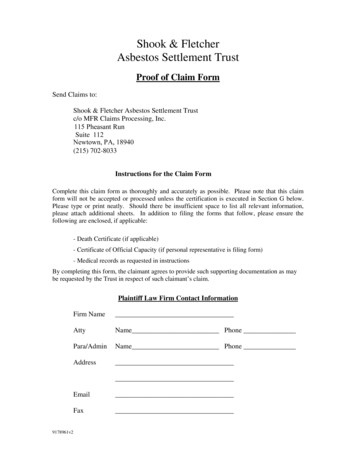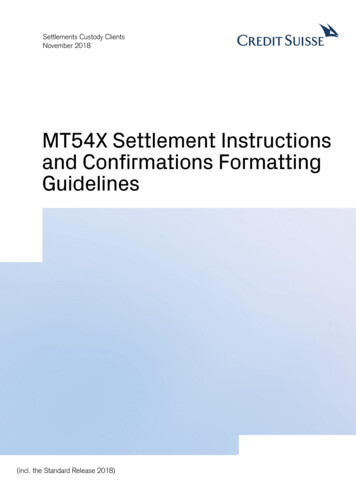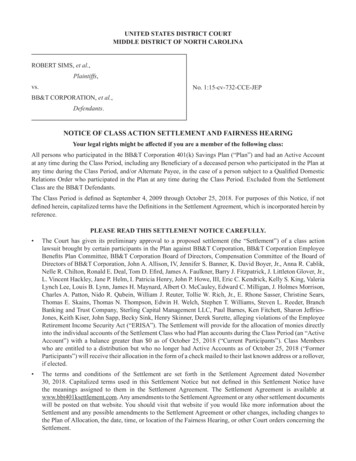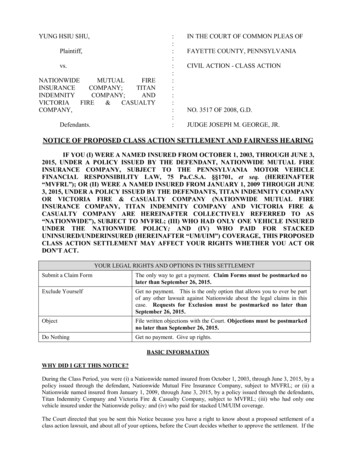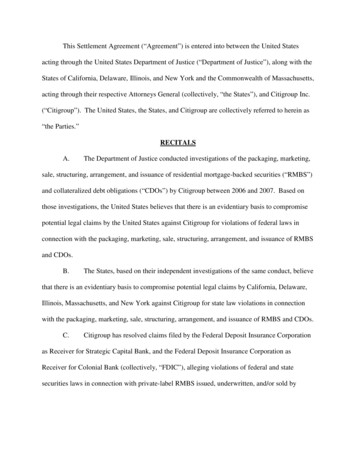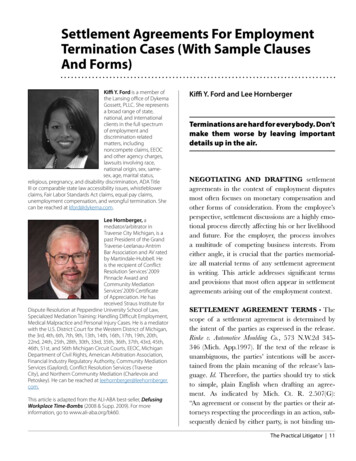
Transcription
Settlement Agreements For EmploymentTermination Cases (With Sample ClausesAnd Forms)Kiffi Y. Ford is a member ofthe Lansing office of DykemaGossett, PLLC. She representsa broad range of state,national, and internationalclients in the full spectrumof employment anddiscrimination relatedmatters, includingnoncompete claims, EEOCand other agency charges,lawsuits involving race,national origin, sex, samesex, age, marital status,religious, pregnancy, and disability discrimination, ADA TitleIII or comparable state law accessibility issues, whistleblowerclaims, Fair Labor Standards Act claims, equal pay claims,unemployment compensation, and wrongful termination. Shecan be reached at kford@dykema.com.Lee Hornberger, amediator/arbitrator inTraverse City Michigan, is apast President of the GrandTraverse-Leelanau-AntrimBar Association and AV ratedby Martindale-Hubbell. Heis the recipient of ConflictResolution Services’ 2009Pinnacle Award andCommunity MediationServices’ 2009 Certificateof Appreciation. He hasreceived Straus Institute forDispute Resolution at Pepperdine University School of Law,Specialized Mediation Training: Handling Difficult Employment,Medical Malpractice and Personal Injury Cases. He is a mediatorwith the U.S. District Court for the Western District of Michigan,the 3rd, 4th, 6th, 7th, 9th, 13th, 14th, 16th, 17th, 19th, 20th,22nd, 24th, 25th, 28th, 30th, 33rd, 35th, 36th, 37th, 43rd, 45th,46th, 51st, and 56th Michigan Circuit Courts, EEOC, MichiganDepartment of Civil Rights, American Arbitration Association,Financial Industry Regulatory Authority, Community MediationServices (Gaylord), Conflict Resolution Services (TraverseCity), and Northern Community Mediation (Charlevoix andPetoskey). He can be reached at leehornberger@leehornberger.com.This article is adapted from the ALI-ABA best-seller, DefusingWorkplace Time-Bombs (2008 & Supp. 2009). For moreinformation, go to www.ali-aba.org/bk60.Kiffi Y. Ford and Lee HornbergerTerminations are hard for everybody. Don’tmake them worse by leaving importantdetails up in the air.NEGOTIATING AND DRAFTING settlementagreements in the context of employment disputesmost often focuses on monetary compensation andother forms of consideration. From the employee’sperspective, settlement discussions are a highly emotional process directly affecting his or her livelihoodand future. For the employer, the process involvesa multitude of competing business interests. Fromeither angle, it is crucial that the parties memorialize all material terms of any settlement agreementin writing. This article addresses significant termsand provisions that most often appear in settlementagreements arising out of the employment context.SETTLEMENT AGREEMENT TERMS Thescope of a settlement agreement is determined bythe intent of the parties as expressed in the release.Rinke v. Automotive Moulding Co., 573 N.W.2d 345346 (Mich. App.1997). If the text of the release isunambiguous, the parties’ intentions will be ascertained from the plain meaning of the release’s language. Id. Therefore, the parties should try to stickto simple, plain English when drafting an agreement. As indicated by Mich. Ct. R. 2.507(G):“An agreement or consent by the parties or their attorneys respecting the proceedings in an action, subsequently denied by either party, is not binding unThe Practical Litigator 11
12 The Practical LitigatorMarch 2010less it is made in open court, or unless evidence ofthe agreement is in writing subscribed by the partyagainst whom the agreement is offered or by theparty’s attorney.”Release Language, Scope, And MutualityTwo of the most significant components in anysettlement agreement are the release of all partiesand the release of all claims. From the employer’sperspective, it is imperative to name all affiliatedor parent corporations, managers, employees,etc., even if not named specifically in the underlying claim(s). See, Collucci v. Eklund, 613 N.W.2d 654(Mich. App. 2000) (upholding the release of otheremployees although employees were not parties tothe release). Some things generally cannot be released, including unemployment compensation andworkers compensation claims, as well as the rightto file a discrimination charge with the Equal Employment Opportunity Commission or cooperatingwith the Equal Employment Opportunity Commission. 29 C.F.R. §1625.22(i)(2); EEOC v. Citicorp Diners Club, 985 F.2d 1036 (10th Cir. 1993), and EEOCv. SunDance Rehabilitation Corp., 328 F. Supp. 2d 826(N.D. Ohio 2004). Most often, plaintiff ’s counselwill attempt to obtain a mutual release. A mutualrelease emphasizes that the parties are actually andforever done dealing with each other. Further, andof particular importance to individual plaintiffs,mutuality in the release recognizes the dignity ofboth parties in the process. ConsiderationConsideration is an important part of theAgreement, and it can take several forms: Severance Pay. When an agreement is negotiated prior to an employee’s termination andsubsequent to litigation, it will generally providefor some sort of severance pay to the employeeas consideration for the employee’s promises torelease the employer and leave his or her em- ployment. Severance pay language ordinarilyaddresses the following points: the amount ofthe severance payment; the structure of thepayments (one lump sum or smaller sums paidover time); the timing of the payment; and howthe payment will be categorized (income, painand suffering, etc.). The agreement should alsocontain a safe harbor provision for the employerin the event a payment is late: If the Employer failsto make any of the payments provided for in this letterby the date indicated for such payment, interest on theunpaid amount will become due and owing at the rate ofone and one-half (1.5) percent per month until paid;Accrued Vacation. If applicable, the agreement should provide for a specific amount to bepaid for accrued vacation and the time by whichsuch amount should be paid. This is preferableto the agreement simply providing that an undetermined amount of accrued vacation will bepaid. From the plaintiff ’s perspective, one wayto handle vacation pay is for the agreement toprovide: Your last day of work will be Friday, June 3,2011. Because of accrued vacation, you will remain onthe payroll for all purposes for an additional four weeksuntil Friday, July 1, 2011;Bonus Plans. The parties should consider theeffect, if any, of bonus plans. Are there bonusamounts to which the employee has a vestedright? What is the past practice or are there anywritten bonus plans in effect?Business Expenses. The document shouldprovide what will be done to reimburse the departing employee for valid business expenses,including expenses already incurred and thosefor which the employee has not yet sought reimbursement;Commissions. The document should address the status of any commissions the employee claims are due and owing. The document should also clarify whether the employeehas claims to any future commissions, and theterms under which such commissions will be
Employment Settlement Agreements 13 paid. Certainly, the employer will want to include a provision confirming it has paid the departing employee for all commissions if that isthe case;Consulting Agreement. In some situations,the parties might enter into an agreement forthe ex-employee to provide future services forthe employer as an outside consultant. Thistype of arrangement can be identified in a Settlement Agreement through a provision similarto the following: The Employer further agrees to retain Jane Smith as an outside consultant pursuant tothe consulting agreement between the parties, a copy ofwhich is attached hereto as Exhibit A;Disability Insurance. The document mightprovide for some continuation of disability insurance. At a minimum, the document shouldspecify what insurance continues, under whatterms, and at whose expense;Health Insurance. The document should describe the parties’ positions concerning healthinsurance, even if only to reiterate the plaintiff ’s COBRA rights. The document might provide for a continuation of health insurance atthe expense of the employer: The Employer willprovide the Employee, beginning May 1, 2011, and atthe Employerís expense, 18 months of COBRA continuation coverage under the Employer’s medical/healthinsurance;Non-Retaliation. In some circumstances,especially with an incumbent employee, theagreement might provide for non-retaliation.Sample non-retaliation language might read asfollows: The Employer agrees that it will not retaliateagainst the Employee because of any allegations involvedin this Agreement;Outplacement Assistance. The agreementmay also provide for the employee to receive direct payment for the amount that would otherwise be paid by the company for outplacementassistance. The provision may read as follows:The Employer will pay to Mr. Smith 10,000.00 for job search counseling and expenses upon signature of thisSettlement Agreement and Release;Pension and 401(k) Plans. The agreementshould provide that no vested pension or benefit rights are waived or released. This wouldprevent an accidental waiver of rights whichthe employee might reasonably have to somemedical insurance benefits as well as 401(k) andpension plan benefits. The following passageis a sample of language addressing this topic:This agreement does not release or waive: (1) your vestedrights and benefits under any pension or welfare benefitplans, (2) any rights you may have under any liabilityinsurance policy, including directors’ and officers’ liability, or under any policy or practice with respect to indemnification of directors, officers, or employees, and (3)your rights under this letter. This Agreement shall haveno effect on the Employee’s vested pension or retirementrights other than making appropriate contributions;Perquisites. Employers may also want to address certain other “perks” of the job in the settlement agreement: The Employer shall provide foryou and your surviving spouse during your respective lives,and free of charge, complete Country Club memberships,including free dues and other fees for you, your survivingspouse, and your immediate family and maximum threeguests, employee discounts and charging privileges, freegolf privileges for you, your spouse and immediate family members. Until July 1, 2011, you will be entitled toan eighteen (18) percent discount on any Company realestate that is for sale and that you wish to purchase. TheEmployer agrees to name, by May 1, 2011, the campus ABC building the “John Smith Building,” and tocontinue to bestow that name upon another appropriatebuilding should the ABC building be destroyed. Otherperquisites might include company automobile, cell phones, condo and timeshare utilization, fax machine, and temporary office spaceor other related amenities;Reinstatement. Under certain circumstances, the agreement might provide for reinstatement of the employee: The Employee will return
14 The Practical Litigator to work on July 1, 2011, in the position of ExecutiveSecretary to the new Financial Vice-President so longas she performs her job duties in a satisfactory manner for ninety (90) days, with the expectation that shewould remain in that position as an employee-at-willthereafter. Other than the ninety (90) -day satisfactoryperformance provision, nothing in this paragraph is intended to reduce, diminish, or enhance the employmentrights and prerogatives, which the Employee had, if any,before July 1, 2011;Relocation Costs. The document shouldalso specifically describe what, if any, relocation costs are to be paid by the employer;Return of Property. The agreement shouldalso account for and document the return ofproperty from the employee to the employer:Employee shall return all Company identification cards,keys, files, customer files, product, financial, marketing,and other business information belonging to the Company, and any other property belonging to the Companythat she may have in her possession. This shall includebut not be limited to the Company vehicle issued to her.By signing this Agreement, Employee acknowledges andconfirms she has returned all property belonging to thecompany;Stock Options. The settlement agreementshould also describe the present status of allstock options, including the non-existenceof certain options. The employer may also,through the settlement document, provide forthe extinguishment of certain options, or set atimetable by which others must be exercised;Unemployment Compensation. If applicable, the agreement may clarify that the employer will not contest or do anything adverseto the employee’s unemployment compensationclaim. It is helpful if the agreement providesthe specific language that the employee will utilize in her claim and the specific language thatthe employer will provide to the unemploymentagency in response to information requests: TheEmployer will provide accurate information regardingMarch 2010your earnings, but otherwise will not do anything, directly or indirectly, to dispute or contest any unemploymentcompensation claims that you might file.COBRASettlement agreements should describe howCOBRA payments will be handled for the employee. Responsibility for COBRA payments is a significant concern to most employees, and the topic isoften addressed in settlement agreements: Employeehas certain rights to continuing health care benefits coverage under COBRA continuation coverage. The Companywill pay the cost of COBRA continuation coverage for Employee’s health, vision, and dental insurance until the end ofJuly 2005, or until Employee accepts full-time employment,whichever occurs first. The Company shall have no furtherobligation concerning Employee’s fringe benefits or other incidents of employment, except to provide Employee with therequired COBRA notice of his right to obtain continuinghealth benefits coverage. It shall be Employee’s responsibilityto apply for COBRA co
to make any of the payments provided for in this letter by the date indicated for such payment, interest on the unpaid amount will become due and owing at the rate of one and one-half (1.5) percent per month until paid; Accrued Vacation. If applicable, the agree-ment should provide for a specific amount to be paid for accrued vacation and the time by which such amount should be paid. This .


